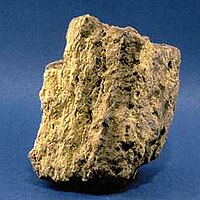
Photo from wikipedia
The accumulation of fat, oil, and grease (FOG) deposits in sewer pipes reduces their conveyance and results in Sanitary Sewer Overflows (SSOs). Previous research has shown that concrete used in… Click to show full abstract
The accumulation of fat, oil, and grease (FOG) deposits in sewer pipes reduces their conveyance and results in Sanitary Sewer Overflows (SSOs). Previous research has shown that concrete used in sewer lines is a significant source for calcium ion, which participates in the FOG deposit formation mechanism. However, no research has been conducted to understand the effect of calcium leaching from cement on FOG deposits formation and adhesion. This study quantifies the reduction in FOG deposit formation when Fly Ash (FA), a Supplementary Cementitious Material (SCM), is used to replace cement in the production of High Volume Fly Ash (HVFA) concrete materials. Results show that after 90 days of leaching test under controlled pH conditions, 75% and 86% reduction in calcium release were achieved from 50% and 75% FA replacement, respectively. After 30 days of FOG deposits formation tests on HVFA samples, 58% and 81% reduction in FOG deposit formation was found for 50% and 75% FA replacement, respectively. FTIR analyses of FOG deposits formed on concrete samples without FA replacement exhibited high calcium soap content (48%), while, FOG deposit formed on HVFA concrete materials showed low calcium soap percentage (22~29%). Furthermore, FTIR analyses report the first spatial variation found in FOG deposits that includes a surface layer of hard FOG deposits with high calcium soap absorbance and an outer layer of soft FOG deposits consisting of a low calcium absorbance. FTIR analyses revealed that the FOG deposit formation mechanism is affected by the availability of calcium and pH near the concrete surface. Finally, HVFA concrete materials were tested for compressive strength and durability against microbially induced concrete corrosion (MICC). After 180 days of sealed curing, HVFA concrete exhibited adequate compressive strength necessary for the sewer line construction and 50% FA replacement revealed satisfactory durability against MICC.
Journal Title: Water research
Year Published: 2020
Link to full text (if available)
Share on Social Media: Sign Up to like & get
recommendations!